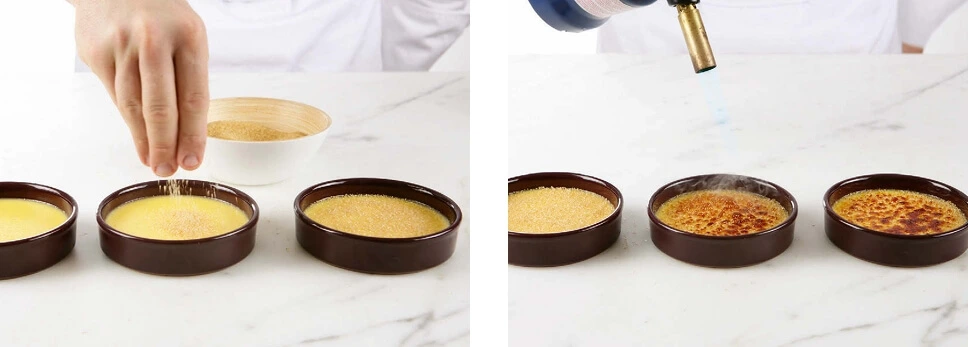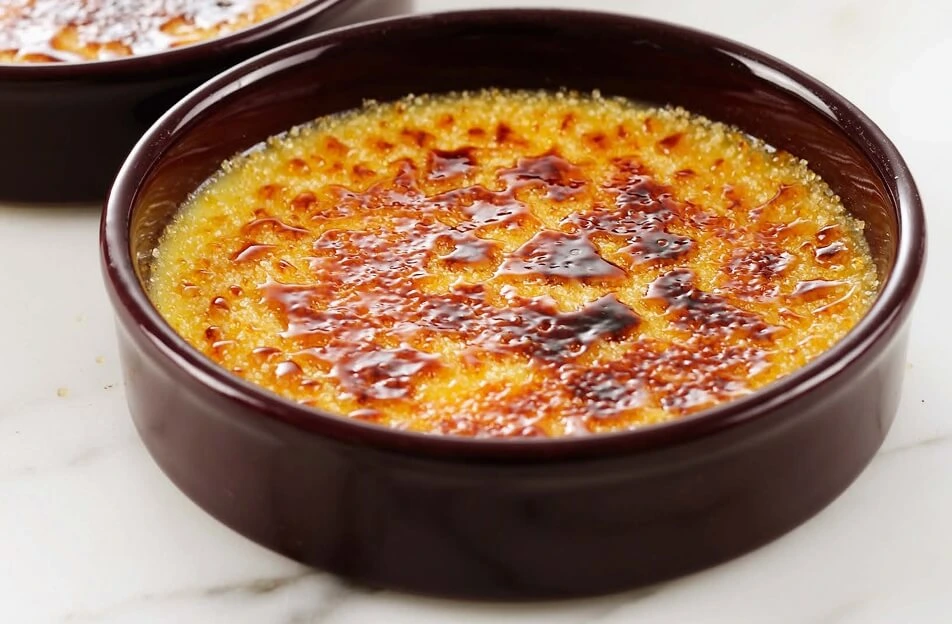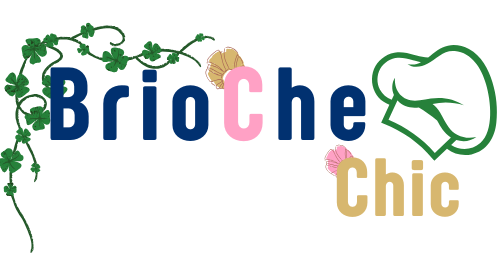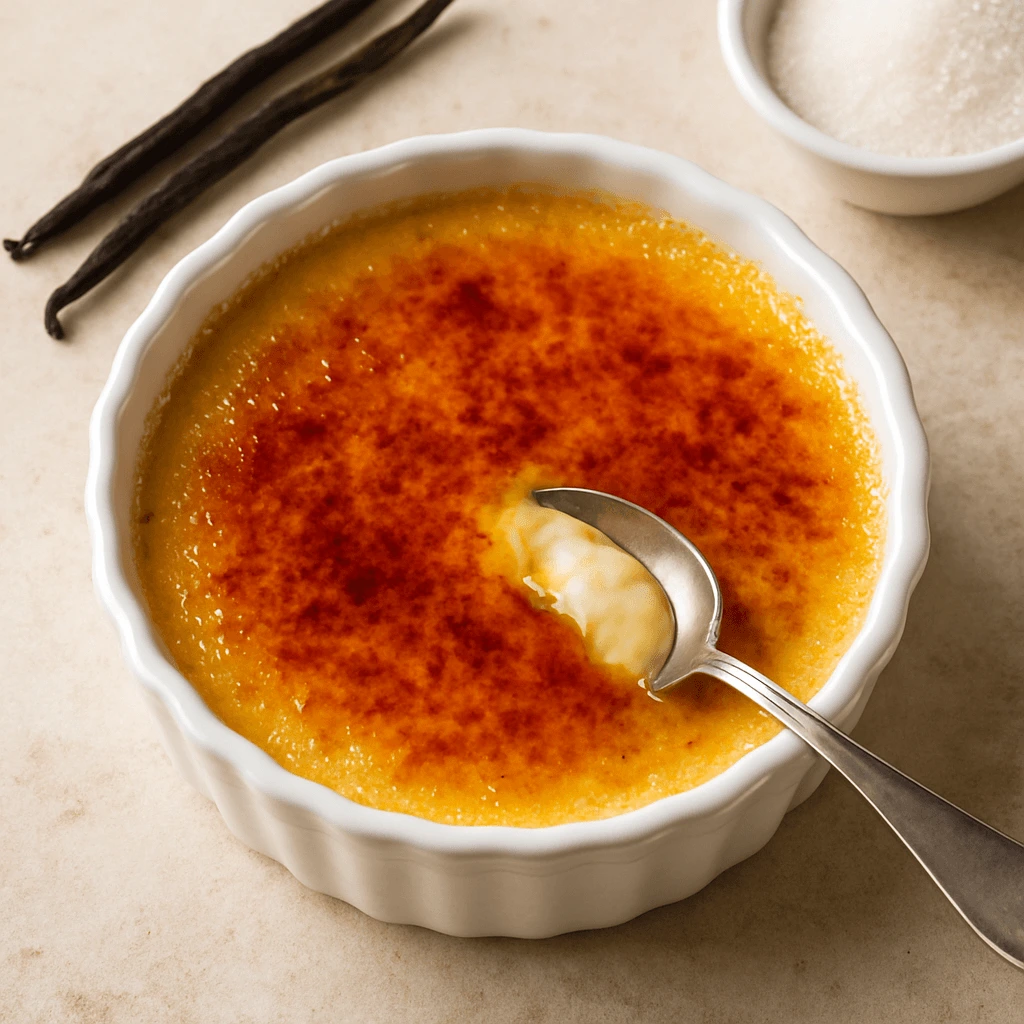Crème brûlée is a timeless and exquisite French dessert that embodies the elegance of simple yet sophisticated flavors. Its name, which translates to “burnt cream,” reflects the duality of its texture and flavor profile: a rich, velvety custard base with a perfectly caramelized sugar topping that adds a satisfying crunch to every bite.
The history of crème brûlée is somewhat debated, with multiple regions in France claiming to be its birthplace. Some say it originated in the royal kitchens of France during the reign of Louis XVI, while others argue it has its roots in the Catalan region of Spain, where a similar dessert, “crema Catalana,” has been enjoyed for centuries. Regardless of its exact origins, crème brûlée has remained a beloved classic in French cuisine and beyond.
What sets crème brûlée apart from other custard-based desserts is its delicate balance of textures. The custard is silky smooth and creamy, providing a comforting foundation that contrasts beautifully with the crisp, caramelized sugar layer on top. The sugar, often sprinkled evenly across the surface, is torched to create a golden-brown crust that offers a satisfying snap when broken through with a spoon.
The beauty of crème brûlée lies not only in its taste but also in its simplicity. It’s a dessert that requires attention to detail and precision to achieve the perfect balance between the custard’s smoothness and the sugar’s crunch. Whether served in individual ramekins or a large dish, it’s a dessert that exudes luxury and refinement, making it perfect for special occasions or a treat to end a meal.
In French culinary tradition, crème brûlée is often served as a symbol of indulgence. Its preparation, while requiring a careful hand and patience, is not overly complex. The slow baking process ensures that the custard sets perfectly, and the final step of caramelizing the sugar brings the dessert to life.
Over time, variations of crème brûlée have emerged, with different flavors infusing the custard or incorporating unique toppings. However, the classic version remains a favorite for its timeless appeal and perfect simplicity. Whether you’re a seasoned pastry chef or an enthusiastic home cook, mastering crème brûlée is a gratifying achievement, one that will undoubtedly impress anyone fortunate enough to taste it.
Crème Brûlée (For 4 Servings)
Preparation: 1 hour
Cooking: 50 minutes
Freezing: 20 minutes
Storage: Up to 3 days in the refrigerator
Equipment Needed:
- Whisk
- Sifter
- Fine-mesh strainer
- Thermometer
- Blowtorch
- 4 ramekins (12 cm in diameter)
Here’s the list of ingredients for the crème brûlée:
- 250 g of heavy cream (35% fat content)
- 50 g of egg yolks
- 40 g of sugar
- 25 g of whole milk powder
- Sufficient brown sugar (cassonade) for caramelizing
Here are the ingredients for a classic English custard (crème anglaise):
- 500 ml of whole milk
- 6 large egg yolks
- 100 g of sugar
- 1 vanilla bean (or 1 tsp of vanilla extract)
Crème Brûlée – Preparation and Chef’s Tips
- Prepare the custard (crème anglaise)
Follow the classic method to prepare the custard. Gently heat the cream and whisk it together with the egg yolks and sugar. Cook over low heat, stirring constantly, until the custard thickens slightly, being careful not to let it boil. You can add vanilla for flavor. - Bake in the oven
Once the custard is ready, pour it into ramekins. Place the ramekins in the oven at 100°C (about 200°F, or gas mark 3/4) for about 50 minutes. The custard should be set but still slightly wobbly in the center. - Refrigeration for the perfect texture
After baking, let the ramekins cool to room temperature. Then, place them in the freezer for 20 minutes. This step ensures that the crème brûlée stays nice and cold when you caramelize the top, which is crucial for getting the perfect contrast between the cold custard and the warm, crispy sugar topping. - Caramelize the sugar
Sprinkle a generous amount of white granulated sugar or brown sugar on top of each custard. Use a blowtorch to caramelize the sugar. Hold the torch at a reasonable distance to avoid burning the sugar too quickly. Rotate the ramekins to ensure an even caramelization.

- Chef’s Tips
- Even caramelization: For a nice caramel crust, be careful not to burn the sugar. The goal is to achieve a golden, crispy layer.
- Chill after caramelization: After caramelizing the sugar, place the crème brûlée in the fridge for a few minutes. This helps the caramelized sugar layer harden, creating a delightful contrast with the cold, creamy custard inside.

Conclusion: Crème Brûlée — A Dessert That Dazzles with Simplicity
Making crème brûlée at home is more than just preparing a dessert—it’s embracing the quiet elegance of French culinary tradition. Beneath its signature crackling sugar crust lies a silky vanilla-infused custard, rich yet delicate, that melts in the mouth and lingers on the palate. The beauty of crème brûlée is in its contrast: hot and cold, crunchy and smooth, rustic and refined.
This dessert may appear simple, but its success hinges on technique: the perfect ratio of cream to yolks, a slow and gentle bake in a water bath, and a sharp blast of heat to caramelize the top just before serving. It’s not a recipe that tolerates shortcuts—but it does reward patience and care.
Whether you’re looking to crown an elegant dinner, impress your guests, or treat yourself to something luxurious, crème brûlée never disappoints. It’s timeless, it’s indulgent, and it’s surprisingly achievable in a home kitchen. All you need is a steady hand, good vanilla, and a touch of fire.
Crème Brûlée FAQ – Your Questions Answered
1. Can I substitute milk for the cream?
Full-fat cream (heavy cream) is essential for the signature rich texture of crème brûlée. You can use a half-milk, half-cream mix to lighten it slightly, but using milk alone will make the custard too runny and less decadent.
2. Can I flavor it with something other than vanilla?
Absolutely! Try infusing the cream with citrus zest, coffee, lavender, tonka bean, or even Earl Grey tea. Just be sure to strain the cream after infusion to keep the texture smooth.
3. Why did my custard turn grainy?
This usually means it was overcooked or baked at too high a temperature. Crème brûlée must be baked low and slow—ideally at 250–275°F (120–135°C) in a water bath—until just set. A slight jiggle in the center is perfect.
4. Do I really need a blowtorch?
A culinary torch is the easiest way to get a crisp caramel crust without warming the custard underneath. You can use your oven’s broiler, but watch closely—the custard can melt or overcook quickly.
5. Can I make crème brûlée in advance?
Yes! In fact, it’s better that way. The custards should chill for at least 4 hours—or overnight—before caramelizing. Just torch the sugar topping right before serving.
6. Can I freeze crème brûlée?
You can freeze the baked custards (without sugar topping) and thaw them overnight in the fridge. However, freezing after caramelizing is not recommended, as the sugar crust will lose its texture.
7. How long should I bake it?
Typically, 40–50 minutes in a water bath at 275°F (135°C), or until the edges are set and the center still slightly wobbly. Remember, it will firm up as it cools.
8. Why isn’t my sugar topping crispy?
Make sure the sugar layer is thin and evenly spread. Use a hot flame (or broiler) and move quickly—don’t let the sugar sit too long after melting, or it will turn sticky instead of crisp.
9. Can I make a sugar-free version?
Yes, but with limitations. Custards can be sweetened with alternatives like erythritol or monk fruit, though they won’t caramelize like real sugar. You can make a creamy dessert, but the iconic crunchy top may be missing.
10. What’s the secret to a truly unforgettable crème brûlée?
Use high-quality ingredients: fresh egg yolks, real vanilla bean, and heavy cream. Don’t rush the baking or the chilling. And always torch the sugar à la minute for that irresistible contrast of hot and cold, smooth and crisp.

